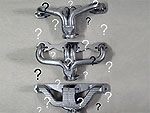
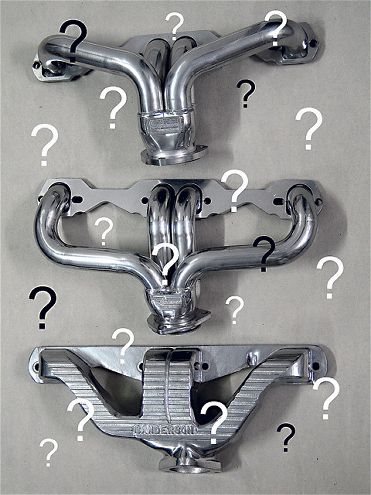 The exhaust port configuration is an important element in your exhaust header selection. Here you can see a D-port configuration compared to a standard port configuration.
The exhaust port configuration is an important element in your exhaust header selection. Here you can see a D-port configuration compared to a standard port configuration.
We all know that exhaust headers were originally designed as a performance product. The equal-length pipes were designed to allow the exhaust gases to escape the cylinder, while at the same time allowing fresh air to travel up the pipe to push the next spent gas charge out of the cylinder. In order to allow the cycle to function at peak efficiency, and develop the most horsepower and torque, the pipe length and pipe diameter were calculated at a specific engine rpm.
Page forward to the current street rod exhaust header and you find that most header manufacturers design their street rod headers to give you maximum performance in a street-driven automobile. However, often in street rod applications, appearance, and more importantly, clearance for the body, engine mounts, steering, etc., dictate header choices. The most common street rod header is the "block hugger" design; a header design that, as the name implies, hugs the block and in most cases offers the most clearance.
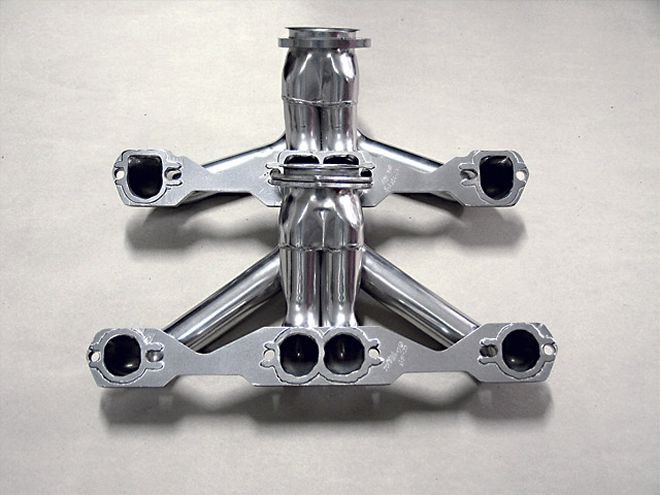 The exhaust port configuration is an important element in your exhaust header selection. Here you can see a D-port configuration compared to a standard port configuration.
The exhaust port configuration is an important element in your exhaust header selection. Here you can see a D-port configuration compared to a standard port configuration.
We also have the Limefire or lakes-style headers. This style of header is normally seen on cars with no hood or no hood sides. The exhaust pipes exit the exhaust ports into a tapered tube that has a block-off plate on the end. The normal street exhaust is taken care of by an exhaust pipe that comes from the tapered tube and exits through mufflers to the rear of the car. For performance use, the block-off plate can be removed, allowing an open exhaust. The Roadster-style headers have exhaust pipes exiting each cylinder rolling down into a long "collector" exhaust that runs parallel to the road. This long collector often contains a baffle or muffler insert. This style of header is widely used on T-bucket roadsters.
Another choice is the various OEM and aftermarket cast-iron exhaust manifolds. While not actually headers, these exhaust manifolds are often designed with performance in mind and in most cases allow even more clearance than headers.Now that we have defined the basic styles of exhaust headers available to today's street rod builder, let's look at the variations in engines and cylinder head designs. The small-block Chevrolet engine has been the most common engine used in hot rods since the mid-'50s when it was introduced as a 265ci V-8. The later 283 and the desirable 327ci engines all used the same basic exhaust port design, thus headers made to fit those popular heads were readily available and were designed to clear the later side motor mounts, popular frames, and most steering applications. The "one-size-fits-all" theory worked fairly wellToday's street rod builder has a host of Chevrolet small-block configurations to choose from, with a variety of cylinder heads, spark plug angels, etc. Fast Burn, Vortec, D Port, and a vast array of aftermarket heads are available. Toss in Ford engines, Mopar engines, and a variety of Buicks, Pontiacs, Cadillacs, etc., and the need for specialized headers becomes apparent. Today's street rod builder must be aware of the header requirements needed in a particular application.
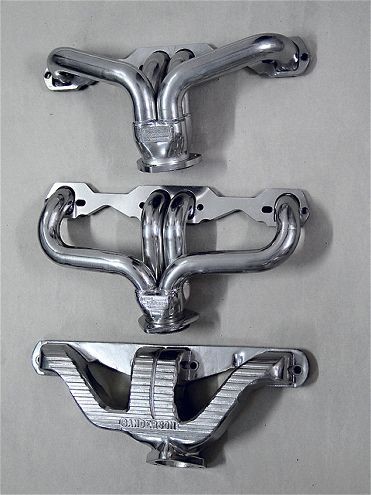 Here are three sets of headers, all designed to fit the GM ZZ4 small-block. The ZZ4 engine features D-port heads and angled spark plugs. While all three designs fit the engine, hood clearance, steering clearance, and exhaust design may all have input into your header selection.
Here are three sets of headers, all designed to fit the GM ZZ4 small-block. The ZZ4 engine features D-port heads and angled spark plugs. While all three designs fit the engine, hood clearance, steering clearance, and exhaust design may all have input into your header selection.
As an example, we recently dropped a mockup 327 block and a pair of fuelie heads in a Model A project we were constructing. Since we planned to run a 327 small-block, we ordered a set of CC1 headers from Sanderson Street Rod Headers and bolted them to our mockup heads. We then proceeded to mock up a set of exhaust pipes to connect the Sanderson headers to a pair of stainless steel mufflers. We then mocked up our steering shafts and universal joints in a manner to clear the headers and exhaust pipes. All went fairly well and we were moving along on the buildup.
Somewhere we got the bright idea to install a GM 350ci Vortec crate engine and scrap the 327 plan. A call to Sanderson told us the headers we had would not work on Vortec heads. We would require CC1 7/8 headers for Vortec heads. The CC1 7/8 is available for most head configurations, but by stating Vortec heads, the center tubes are "dimpled" to clear the center spark plugs that, on Vortec cylinder heads, are located closer together. We ordered those headers and were happy to find out that the steering cleared and our previously constructed exhaust would work as well.
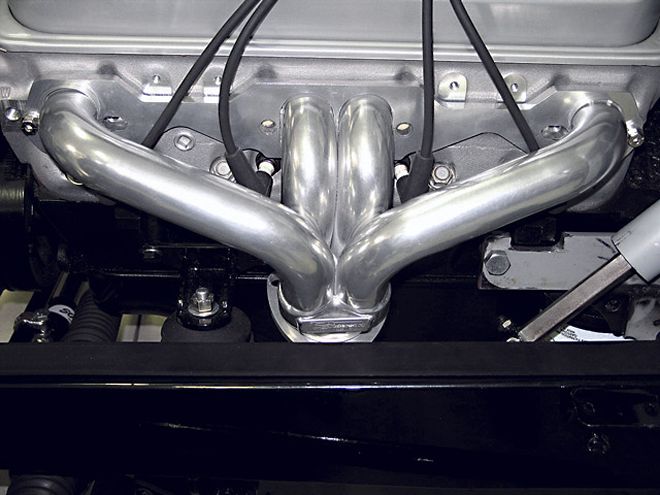 Here's the Sanderson CC1DP header installed on a ZZ4 small-block. In our application, the front tube on this header interfered with the hood sides and the exhaust dump came close to our steering shaft.
Here's the Sanderson CC1DP header installed on a ZZ4 small-block. In our application, the front tube on this header interfered with the hood sides and the exhaust dump came close to our steering shaft.
Not long after that engine decision, a 350ci ZZ4 GM crate engine became available at a great buy and we made another engine change. Now we had D-port heads and angled spark plugs. This required another call to Sanderson and another set of headers. However, the CC1DP headers designed for this application did not allow enough steering clearance and the previously constructed exhaust pipes would not fit properly. By chance, we found that the hood sides also interfered with the CC1DP header configuration. Somewhat embarrassed and in total frustration, we made another call to the fine folks at Sanderson. Once again they came through with two suggestions. We could utilize the QP1000 Sanderson cast-iron headers that are available in a D-port design, or we could try CC5 headers. Unlike the CC1DP where the pipes came out and around the front and rear spark plugs and caused the hood interference, the CC5 front and rear tubes drop straight down out of the header flange to clear the angled plugs and then cross over to the collector. The CC5 headers also tuck in closer to the block and drop down further than the CC1DP, thus eliminating our steering interference.
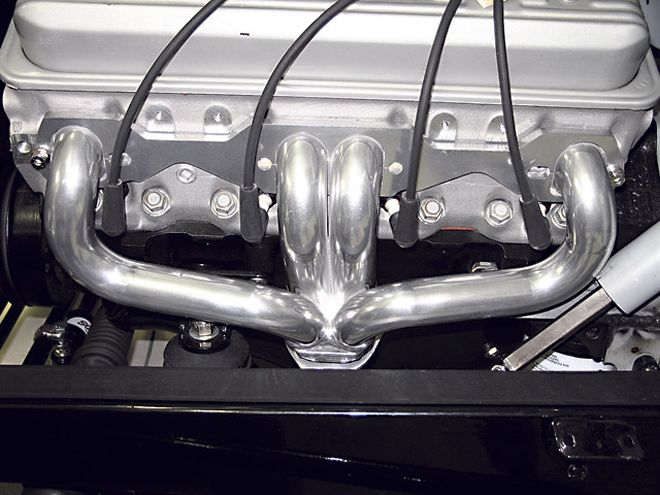 The Sanderson CC5 header solved our hood side interference problem and, since the center dump is further down, we gained more clearance for our steering shaft.
The Sanderson CC5 header solved our hood side interference problem and, since the center dump is further down, we gained more clearance for our steering shaft.
The Sanderson QP1000 cast-iron headers are a tight-fitting, performance exhaust manifold. For top performance, built-in anti-reversion baffles prevent spent exhaust gas from being drawn back into the cylinder during valve timing overlap when both the intake and exhaust valves are open. In addition to performance, the QP1000 fits tighter than most tube-style headers. While not as popular in street rod applications as tube headers, according to the folks at Sanderson, the QP1000 cast-iron headers are the most popular '55-57 Chevrolet headers.Both the QP1000 cast-iron headers and the CC5 headers solved our steering and hood interference problems, but either choice would require a new exhaust hookup. We chose the CC5 because they gave us the most spark plug wire clearance and, in our opinion, they just look better than cast-iron headers when bolted to a street rod engine.
Luckily for us, the staff at Sanderson was very accommodating and allowed us to return our unused, non-fitting headers, even though our engine changes were responsible for the header fit problems. However, we still have a few extra dollars tied up in return freight costs. Donna Smith, co-owner of Sanderson Street Rod Headers, tells some customers "you may be trying on headers the same way I try on shoes."
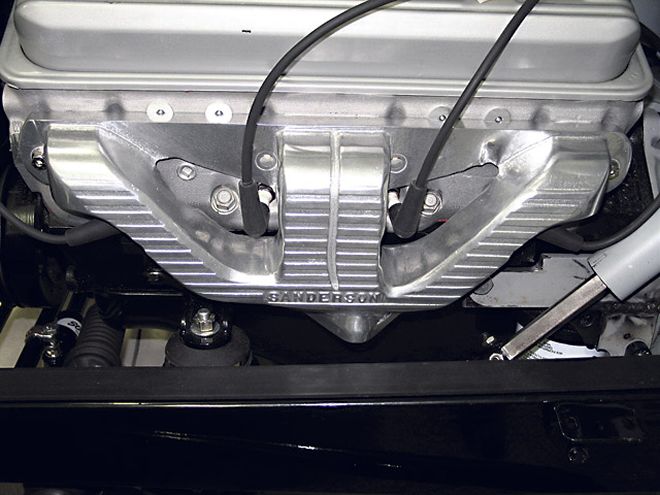 The Sanderson QP1000 cast-iron header solved all of our clearance problems as well. However, we preferred the looks of a tube header on a street rod, so we opted for the CC5. The QP1000 is a popular choice for Tri-Five Chevrolets.
The Sanderson QP1000 cast-iron header solved all of our clearance problems as well. However, we preferred the looks of a tube header on a street rod, so we opted for the CC5. The QP1000 is a popular choice for Tri-Five Chevrolets.
We have conversed with a fellow rodder who is on his second set of Ford headers. In his case the motor mount configuration caused the problems. The moral of this story is, regardless of what type of engine you have selected for your street rod, when ordering headers, supply your header manufacturer with all of the pertinent data. Donna claims that the greatest problem Sanderson encounters is customers not knowing the cylinder head configuration they have and possible clearance issues. Take measurements, make sketches, etc.
Buying that set of one-size-fits-all headers at the local swap meet or car show may work out fine, but with today's various cylinder head configurations, motor mount choices, and steering configurations, chances are it will not.